They say… 
Best beer and travel writing award 2015, 2011 -- British Guild of Beer Writers Awards
Accredited Beer Sommelier
Writer of "Probably the best book about beer in London" - Londonist
"A necessity if you're a beer geek travelling to London town" - Beer Advocate
"A joy to read" - Roger Protz
"Very authoritative" - Tim Webb.
"One of the top beer writers in the UK" - Mark Dredge.
"A beer guru" - Popbitch.

|
Top Tastings 2008. A shorter version first appeared on facebook January 2009.
ABV: 13%
Origin: Chicago, Illinois, USA
Website: http://www.gooseisland.com
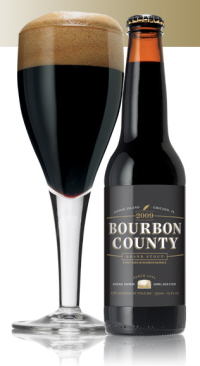 Goose Island Bourbon County Stout Originally brewed to celebrate this outstanding brewery’s 1000th batch of beer in 1992, this became the USA’s first cask matured beer and started a cult phenomenon among enthusiasts. The first batches were matured in ex-Jim Bean casks, but the batch I sampled, at a beer dinner hosted by the brewery at the White Horse, Parsons Green, London (one of the beer events of the year) had enjoyed 100 days in Hampden Hill/Buffalo Trace casks before being bottle conditioned. It’s made using a single hop, Willamette, to an IBU of 60, and a complex grist that includes two row pale, Munich, Chocolate, Caramel and debittered Black malts and roasted barley.
The result was black with a sparse pinky brown head, a malty smoky vanilla, mint, chocolate and raisin aroma with some heady whisky cask fumes. A minty gravy malt palate was syrupy but very drinkable, recalling the old Courage Imperial Russian Stout, but with clear bourbon notes, salty sharpness and stinging hops penetrating the malt. The beer finished creamy and meaty with notes of Belgian chocolate couverture. A truly astonishing brew.
Read more about this beer at ratebeer.com: http://www.ratebeer.com/beer/goose-island-bourbon-county-stout/8909/
Top Tastings 2008. A shorter version first appeared on facebook January 2009.
ABV: 5%
Origin: Sint-Ulriks-Kapelle, Vlaams Brabant, Vlaanderen
 Brouwerij Girardin For the style this is easy drinking but top quality from one of the most respected lambic breweries, a cherry-red beer with a creamy, woody and tannic aroma rich and oily with natural cherry skin perfume. A spicily fruity natural cherry palate has thick and sappy lambic and mint notes, a poised sweet-tart balance , and a chewy finish with lingering cherrry notes that’s fresh and fruity but not oversour. Unfiltered and sampled on CO2 pressure at the Zythos Beer Festival.
Read more about this beer at ratebeer.com: http://www.ratebeer.com/beer/girardin-kriekenlambik/23578/
Top Tastings 2008. A shorter version first appeared on facebook January 2009.
ABV: 4.7%
Origin: Breendonk, Antwerpen, Vlaanderen
Website: www.vedett.be, www.duvelmoortgat.be
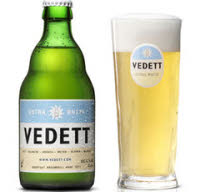 Duvel Moortgat Vedett Extra White Previously Duvel Moortgat’s wheat beer offering was Steendonk, produced in partnership with Palm, but the partnership ended this year and this beer, DM’s very own replacement, came as a pleasantly good surprise.
It’s cloudy and very pale, with a spicy damp hay, phenol, vanilla and spiced orange aroma. The citric, wheaty palate is well-integrated with a lemon note. An astringent hop charge leads to a crisp citric swallow, then a smooth lemony finish with a hint of chewy hops.
OK, it’s a bit lacking in substance and overbalanced by citric lemon squash flavours, but it’s friendly and refreshing. Sampled bottled at Bar Fringe, Manchester.
Read morea bout this beer at ratebeer.com: http://www.ratebeer.com/beer/vedett-extra-white/91232/
Top Tastings 2008. A shorter version first appeared on facebook, January 2009.
ABV: 5.8%
Origin: Roncole Verdi, Emili-Romagna, Italy
Website: www.birrificiodelducato.com
 Birrificio del Ducato Nuova Mattina (New Morning) I first encountered this unusual saison-style Italian craft brew, “dry herbed” with ginger, green and red pepper, coriander and chamomile, on draught at the Pigs Ear beer festival. Jon, barman at the imported beer bar, and myself agreed that “New Morning”, as it is sometimes labelled, was weird but notable. I noted a hazy blond ale with a thick white head and a twiggy sourish perfumed spice aroma. A fruity pineapple, grapefruit, rose and strawberry palate had a stab of sourness that could have been unintentional but would work well as a nod to Orval. Alcohol was evident on a chewy, subtly spiced, estery and notably long finish, with late varnish notes. It was remarkable enough to make my top tastings of the year.
A bottled version tried several months later at a Ducato tasting at the Rake had a striking spicy aroma that was sweetish and alluring. A peppery palate had complex but not overbearing spices, with a clear ginger note and a touch of not-unpleasant deterget. A lingering bitter and spicy finish is reminiscent of Indian paan but with plenty of decent blond malt beneath.
I’ve been very impressed by Ducato beers overall; I still can’t quite make up my mind about this one but the beer world would be worse off without it.
Read more about this beer at ratebeer.com: http://www.ratebeer.com/beer/birrificio-del-ducato-nuova-mattina-new-morning/76706/
Top Tastings 2008. A shorter version appeared on facebook, January 2009.
ABV: 4.5%
Origin: Sunderland, England
Website: www.durhambrewery.com
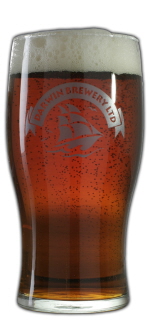 Darwin Brewery This brewery specialising in historical recreations has an interesting history itself. It began in 1994 as a teaching facility at Brewlab, the University of Sunderland’s well reputed brewing school, initially expanding to take over the old Hodge’s Brewery in Crook and moving back to Sunderland in 2002 to take over the brewing kit of the well respected but sadly defunct micro Butterknowle. Operated as a commercial undertaking but still with links to Brewlab, it’s since become an multi-award winner in its own right.
Richmond Ale is based on the traditional strong dry brown ales of northeast England that originally developed in the late 19th century — this particularly recipe comes from Richmond, North Yorkshire. It’s brewed from Yorkshire malts, including specialist crystal malts, and Fuggles hops. There are cask and filtered bottled versions but a Real Ale in a Bottle occasionally emerges — I caught one at the bottle conditioned bar at the Great British Beer Festival in 2008.
The more widely available filtered version is nonetheless a great beer, a deep bronze colour with a fine off-white lacy head and a pleasant chestnut cream and vanilla malt aroma. The sweetish toffee palate has a touch of fruit and notable roasty smoky flavours, and twiggy, herbal hops emerge on a soft rounded finish that makes for a dry but very drinkable beer.
The bottle conditioned version is a more complex proposition, with a more fruity and nutty aroma, with raisins and figs tinged with yeasty esters reminiscent of Belgian abbey browns. A sappy, slightly roasty palate has plenty of orange and blackcurrant fruit, subtle resins and a hint of belt leather. The hops are burry but subtle and gentle, again developing a pleasant dry bitterness in a long, sappy and fruity finish with more mineral, cindery roast flavours.
Read more about this beer at ratebeer.com: http://www.ratebeer.com/beer/darwin-richmond-ale/1080/
 Great British Beer Festival 2010 The Great British Beer Festival (GBBF), organised annually by the Campaign for Real Ale (CAMRA), is a remarkable event. This year almost 67,000 people, about 5% more than last year, drank about 114,000l (200,000 pints) of over 700 beers, faciliated by over 1,000 volunteers. This makes it the biggest event of its kind in the world. Its nearest competitor, the Great American Beer Festival (GABF), taking place in just over a month’s time, is expected to welcome 49,000 people — the beer choice will be much wider, but only available for tasting in miniscule measures.
The event easily fills the windowless cavern of Earls Court, Central London’s biggest exhibition venue, to occasionally uncomfortable levels, with an impressively broad spectrum of beer drinkers. It’d be silly to pretend you don’t see anyone conforming to the popular stereotype of the CAMRA member, but they are very much the minority. The crowd covers a range of ages, a decent balance of gender (though still a bit heavy on the XY chromosomes) and even makes a respectable stab at ethnic diversity. Beer bellies in worn ‘Afraid you might taste something Lagerboy?’ T-shirts and twitchy ticking geeks rub shoulders with normal people out with mates and colleagues; suits and power frocks mix with punky-haired surf types. The dressers for fun range from fabulously stylish — a file of women in glamorous vintage evening wear wafted down the escalator from the members’ lounge — to embarassing — the business suited young man dressed to appear as if he had a giant furry penis stuck through his head hit a new nadir in the unfortunate festival tradition of “wacky” headgear. But everyone gets on in a good natured way. It’s signficant that, given the amount of alcohol consumed, this huge event is remarkably trouble-free, a fine advertisement for our capability to drink responsibly if we choose.
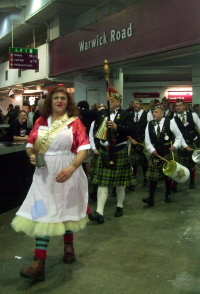 The festival inevitably embodies some of the contradictions of the organisation that runs it. CAMRA’s official priority is to promote British cask beer, with bottle conditioned and/or imported craft beers, plus real cider and perry, as a footnote. But the festival has become an international celebration of beer itself, with the imported beer bars, Bières sans frontières (BSF), an attraction in themselves, a rallying point for the worldwide craft brewing community, of which more later. CAMRA does recruit at the festival — this year it signed up about 1,000 new members — but it still struggles to connect with the majority of visitors. Most are there to enjoy good beer in good company, in the same way they enjoy other fine things in life, and aren’t too worried about matters such as the amount of foam on their pint, or whether or not Marstons’ new Fast Cask system of jellied yeast pellets counts as real ale. The festival inevitably embodies some of the contradictions of the organisation that runs it. CAMRA’s official priority is to promote British cask beer, with bottle conditioned and/or imported craft beers, plus real cider and perry, as a footnote. But the festival has become an international celebration of beer itself, with the imported beer bars, Bières sans frontières (BSF), an attraction in themselves, a rallying point for the worldwide craft brewing community, of which more later. CAMRA does recruit at the festival — this year it signed up about 1,000 new members — but it still struggles to connect with the majority of visitors. Most are there to enjoy good beer in good company, in the same way they enjoy other fine things in life, and aren’t too worried about matters such as the amount of foam on their pint, or whether or not Marstons’ new Fast Cask system of jellied yeast pellets counts as real ale.
These contradictions are contained — just — by the de facto overlap between “real ale” and fine beer in the UK, but that is increasingly coming under (CO2) pressure. This year I went for the first time to the British Guild of Beer Writers’ pre-festival reception on the Monday night. On a temporary stillage in the large back room at Brew Wharf in the Borough was a good range of casks from brewers in and around London, and at the end of these a couple of lonely keg taps which piqued my curiosity. They were dispensing beers from the Camden Town brewery, an outfit newly expanded from a small plant at the Horseshoe pub in Hampstead. One was an excellent Helles, the other an American-style pale ale. I was introduced to the Australian brewery owner and his head brewer, a young Dane, neither of whom have any special loyalty to cask, but they do have a determination to produce quality characterful beer. The fact that it wouldn’t be allowed at a CAMRA festival on technical grounds while clearly inferior products would is one thing I hope the forthcoming review of CAMRA’s policy and direction will have the courage to address.
 The Great British Beer Festival 2010. It was big. That’s not to say that the quality of good cask beer is anything less than breathtaking. The offer at the Beer Writers’ evening included some winners: East London’s Brodie’s continued to dazzle me with their Summer Stout, absolutely packed with flavour and yet only 2.7% ABV. The Champion Beer of Britain (CBoB) final, which takes place at GBBF, also affirms the potential of British cask ale at its best. This year’s list of category winners was impressively diverse in number and type of breweries. The overall gold and silver medallists, respectively Castle Rock Harvest Pale and the well-known Timothy Taylor’s Landlord, are both outstanding, and contrasting, examples of top notch cask.
And yet, regarding the massed ranks of pale and golden ales of between 3.5% and 4.8% ABV that still form the majority of beers on offer at the British bars, this year arranged rather bafflingly according to “counties” of the organisers’ own devising, I couldn’t help but think British brewing needs an injection of excitement, experimentation and pizzazz. There’s a buzz to the BSF bars, a sense of adventure and discovery, that doesn’t quite extend to the rest of the hall (I can’t speak for the cider and perry bar as it’s beyond my expertise). There are plenty of British brewers among the drinkers but the BSF bars attract brewers and brewing personalities to volunteer. Menno Olivier of De Molen at Bodegraven near Rotterdam is a regular visitor and this year brought three giant wooden casks of special editions. Alex Liberati, of Rome’s cutting edge Brasserie 4:20 beer pub and the Revelation Cat beer firm, was conducting informal tastings of Italian craft brews. And thanks to an expanded partnership with the Brewers’ Association, GBBF this year had its biggest ever range of US craft brews, including around 100 in cask.
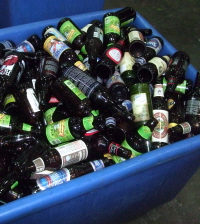 Great British Beer Festival 2010. Hundreds of unusual US craft brews but the punters still go for the tried and tested! More special and unexpected attractions such as this could be strategically spread around the festival — genuine ones, not the ticker beers that blight some CAMRA festivals. The British Real Ale in a Bottle Bar, though staffed by hard working volunteers and with a great selection which always claims some of my carry out allowance, could do with some more unusual brews and perhaps some spontaneous tastings and brewer involvement. Fuller’s did its bit by releasing a firkin a day of the rare cask version of Brewers Reserve No 2 aged in cognac barrels at its brewery bar. Thornbridge, one of the most adventurous British brewers, had a brewery bar for the first time but played safe by concentrating on its cask session ales, rather than the amazing wood aged imperial stouts it had at the Pré-ZBF event in Flanders back in March.
One new perspective I enjoyed this year was volunteering for the first time — I spent the Wednesday behind the BSF Belgian, Dutch and Italian bar. As you’ll recall from the statistics quoted above, that makes me one of over 1,000. If you’ve been to GBBF you’re probably at least dimly aware that it’s run by this huge army of volunteers, but you may well not have thought through exactly what that means. I hadn’t either, until I became a volunteer and started thinking about the immensity of it all. It’s physically brought home to you when you walk through the staff entrance opposite West Brompton tube and go up to the 5300m², 2000-capacity Brompton Hall on the first floor, which serves during the festival as the Volunteer Village, complete with its own bar, the Volunteer Arms.
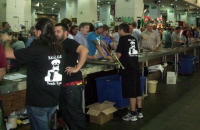 Great British Beer Festival 2010: the view from the other side of the bar, in this case the BSF Dutch/German/Italian one. The festival organiser, Marc Holmes, is himself a volunteer, and under him is a well organised structure of coordinators, managers and rank and file, all working with the sort of efficiency and smoothness that would do a professional events company proud, except that a company would charge serious money for delivering something of this size. Sometimes activities run by long standing volunteers can be a bit cliquey and unwelcoming, but at GBBF quite the reverse was the case. Everyone was lovely — and I know some of them recognised my name, but I genuinely think they would have been as nice to anyone.
Working behind the bar was both an enjoyable and a beneficial experience. Bar manager Roger explained that the customers split broadly into two groups: seasoned beer hunters who know exactly what they want, and people trying new things that need advice and recommendations. I was glad to deal with both, but it was good to meet those in the latter group, given that most of the people I discuss beer with are geeks like me. I knew for example, about the popularity of fruit beers with people who aren’t hardened beer drinkers, but it was very instructive to see it in action. It’s made me realise that one day I really must try a bottle of Drie Horne Bananatana. I was hoping to serve one to Penis-Head, but he asked for the best beer on the bar and my honesty compelled me to sell him a bottle of Rochefort 10.
Festival web pages: http://gbbf.camra.org.uk
Beer picks
- Brodie’s Summer Stout 2.7% London E10, England
- Camden Town Helles 4.8% London NW5, England
- Rebellion IPA 3.7% Marlow, Buckinghamshire, England
- Fuller’s Brewer’s Reserve No 2 7.7%, London W4, England
- Port Older Viscosity 2009 12.5% San Marcos, California, USA
- Molen Revelation Cat Whole Milk Mild 3.5% Bodegraven, Zuid-Holland, Netherlands
Top Tastings 2008. A shorter version was first published on facebook January 2009.
ABV: 6.8%
Origin: Piozzo, Piemonte, Italia
Website: www.baladin.it
 Baladin Nora Birra Egizia The restlessly creative Teo Musso is one of the pioneers of the new wave of Italian craft brewers: his brewpub Baladin dates back to 1996 and originally showed a strong Belgian influence attributed to the Flemish background of Teo’s Lille-born wife Nora. But since then he’s really pushed the envelope with unusual grains, flavourings and techniques, the last including playing music to maturing casks. Eccentricities aside, he seems incapable of producing a beer less than interesting.
This ‘Egyptian beer’ named after Nora is an organic wheat beer made partly from the ancient Egyptian kamut variety of wheat, and following other fragments of what we now about the brewing practices of the civilisation that built the pyramids, is flavoured with ginger and myrrh.
It’s a cloudy orange with a thick slightly orange-tinted head and an unusual very grassy and chaffy aroma with notes of aniseed, lemon, camomile and liquorice. The palate is smooth and lightly citric with date-like fruit and distinctive herbal notes, finishing mild but refreshingly grainy with summer grass and a dash of hops, very easy drinking for its ABV. Bought at the Great British Beer Festival.
Read more about this beer at ratebeer.com: http://www.ratebeer.com/beer/baladin-nora/14552/
Great British Beer Festival 2010
ABV: 3.5%
Origin: Bodegraven, Zuid-Holland, Netherlands
Website: www.brouwerijdemolen.nl
 Revelation Cat Whole Milk Mild This is a beer deserving of the description ‘eclectic’: a cross between two traditional and somewhat neglected English beer styles, mild and milk stout, commissioned by an Italian and brewed by a Dutchman. The idea was dreamed up by beer guru Alex Liberati, of Rome’s celebrated beer bar Brasserie 4:20, for his Revelation Cat beer firm. Like some of the cutting edge brewers now doing the rounds in Europe, Alex doesn’t have his own kit, but works at other people’s breweries. For this beer, he approached Menno Olivier at De Molen, no stranger to collaborations on unusual beers, and Menno perfected the recipe.
It involved obtaining supplies of proper English mild ale malt, once a mainstay of British brewing but now something of a speciality line, and expensive to ship across the North Sea in small quantities. The hops are the Czech varieties Premiant and Sladek, the latter one of the Žatec hybrids. The beer is also dosed with lactose, the unfermentable sugar that lends a characteristically sticky sweetness to milk stout — the label states 25kg was added per 800l, which by my reckoning works out to about 31g/l.
The result is a dark brown beer with a fine, thick yellow-beige head. The rather oily and inviting aroma is tinged with drinking chocolate powder and dark malt, leading to a big bodied, sweetish and aromatic palate with the quality of milk chews, lifted by tangy, lightly acidic fruit and a touch of roast. A soothing, decently chewy and very lingering finish has cinder toffee notes and a light touch of roast.
The beer attracted deserved interest at the Great British Beer Festival — all that trouble to source the mild malt was clearly worthwhile. I’ve a soft spot for dark, sweetish low gravity beers anyway, but even if you don’t, this is well-balanced enough to please, and that indulgent oily lactose note is enough to make a cat purr.
Read more about this beer at ratebeer.com: http://www.ratebeer.com/beer/revelation-cat-milk-mild/110751/
Great British Beer Festival 2010
ABV: 12.5%
Origin: San Marcos, California, USA
Website: www.portbrewing.com
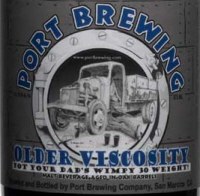 Port Older Viscosity Port Brewing is one of the leading lights of West Coast craft brewing, particularly for the Lost Abbey series of special beers created by its head brewer Tomme Arthur. At GBBF, Older Viscosity was labelled a Lost Abbey beer, but it’s actually a plain Port production — in as much as an extraordinary 12.5% wood aged barley wine can be described as plain. Older Viscosity began life as a mere component in the brewing process of Old Viscosity, a more commonly available 10.5% strong dark ale that draws on the technique of ageing and blending inspired by traditional but now near-vanished European processes. Old Viscosity is a blend of 80% of a fresh beer fermented in stainless steel from two row pale, US and English crystal, Carafa III and chocolate barley malts, wheat malt and German Magnum hops, blended with 20% of the same beer matured in refill Bourbon barrels. Older Viscosity is the neat Bourbon-matured stuff, two vintages of which were available in cask at the Great British Beer Festival as part of that event’s most impressive array yet of US craft beers.
I sampled the 2009, a jet black beer that smelled of typewriter ribbons (remember them?), its aroma an intoxicating burst of vivid scents including dark malt, blueberry, mint and whiskyish hard liquor. A lovely slick palate was lightly chocolatey and oily, with rich fruit cake and sultanas, more berry fruit and some definite bourbon notes. A grainy swallow heralded a warming, sticky, fruit cake and rye bread finish that was long and alcoholic but very soft, gently and soothing, with a just a hint of wood. A beautiful, world class special beer that brought my first day at GBBF to a perfect close.
Read more about this beer at ratebeer.com: http://www.ratebeer.com/beer/port-brewing-older-viscosity/66624/
Great British Beer Festival 2010
ABV: 7.7%
Origin: London W4, England
Website: www.fullers.co.uk
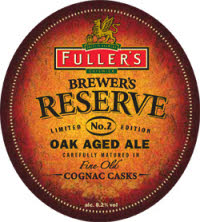 Fuller's Brewer's Reserve No 2 Limited Edition Oak Aged Ale The Brewer’s Reserve series is Fuller’s head brewer John Keeling’s limited edition of wood aged beers, starting with a Glenmorangie whisky cask version in 2008. The second edition uses the same beer recipe but matured for a year in oak Cognac barrels. Though primarily intended for limited edition bottling, some of the beer has been put into draught casks, and Fuller’s were tapping one firkin a day at their brewery bar at this year’s Great British Beer Festival. I’m grateful to the neatly suited blokes from the brewery who spotted my Fine Ale Club polo shirt and pointed me in the right direction at the right time.
The beer is a pale Tizer-like amber, with only a little bubbly head. The aroma has that instantly recognisable orangey Fuller’s note that blends with the spirity notes from the Cognac to give an impression of orange liqueur. It’s quite intoxicating and also includes wafts of wood and oaked chardonnay. A rich, complex and sweetish palate is honeyed and thick, with more wood, tangy orange and spirit notes well blended with the malty beer character. A long and chewy finish is generously fruity and mouth coating.
This matches its predecessor in being a very interesting, enjoyable and well made beer, fine but approachable. John has raised the bar very high with mind-blowing masterpieces like his Vintage Ales, especially when they’re given some age — while not quite reaching that level, these Reserve beers are a very welcome addition to an impressive range.
Read more about this beer at ratebeer.com: http://www.ratebeer.com/beer/fullers-brewers-reserve-no-2/127709/
|
Cask  This pioneering new book explains what makes cask beer so special, and explores its past, present and future. Order now from CAMRA Books. Read more here. This pioneering new book explains what makes cask beer so special, and explores its past, present and future. Order now from CAMRA Books. Read more here.
London’s Best Beer  The fully updated 3rd edition of my essential award-winning guide to London’s vibrant beer scene is available now from CAMRA Books. Read more here. The fully updated 3rd edition of my essential award-winning guide to London’s vibrant beer scene is available now from CAMRA Books. Read more here.
|


















